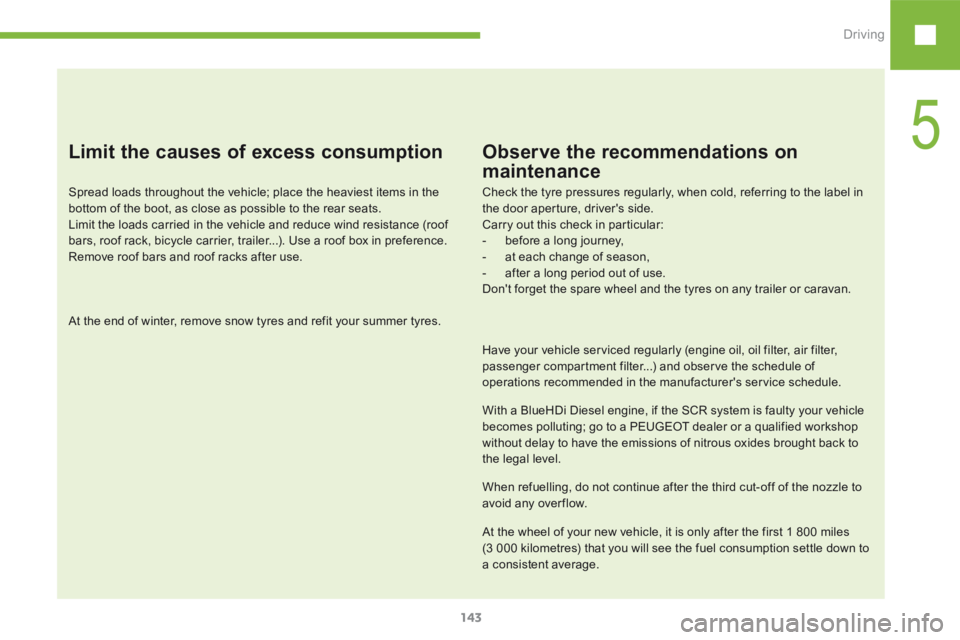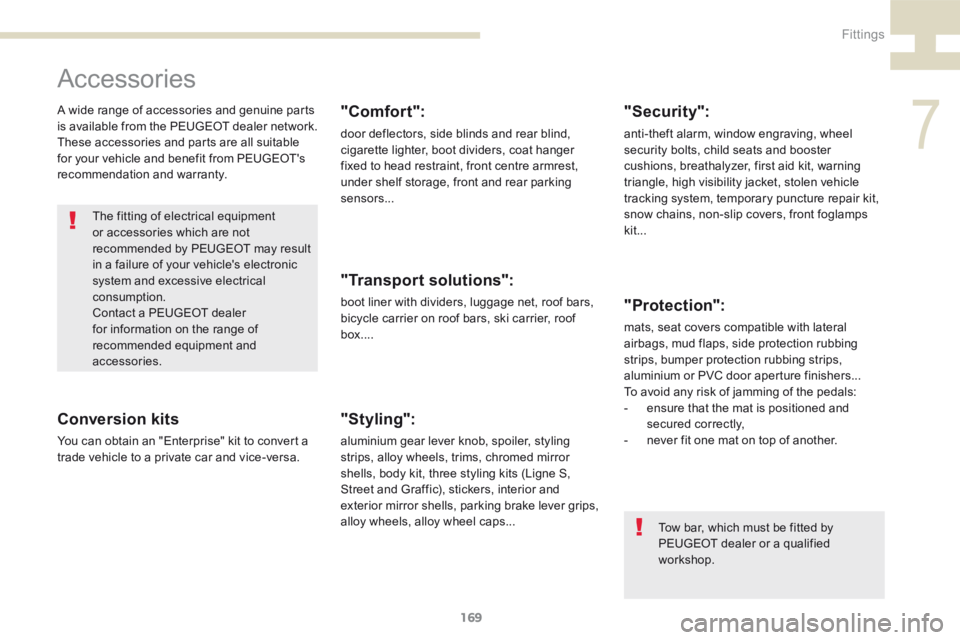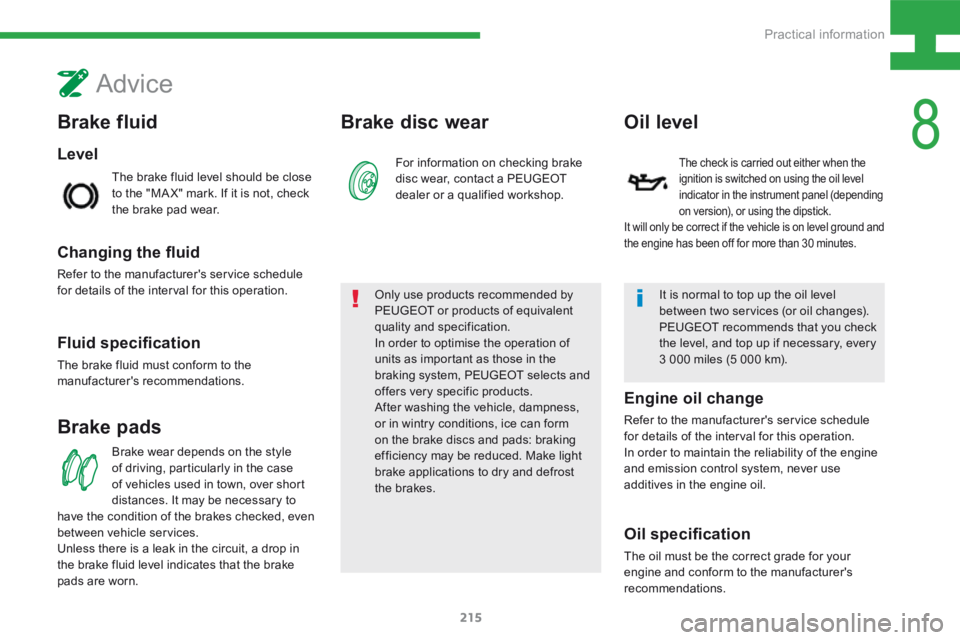Page 145 of 341

143
208_en_Chap05_conduite_ed01-2015
Limit the causes of excess consumption
Spread loads throughout the vehicle; place the heaviest items in the
bottom of the boot, as close as possible to the rear seats.
Limit the loads carried in the vehicle and reduce wind resistance (roof
bars, roof rack, bicycle carrier, trailer...). Use a roof box in preference.
Remove roof bars and roof racks after use.
At the end of winter, remove snow tyres and refit your summer tyres.
Observe the recommendations on
maintenance
Check the tyre pressures regularly, when cold, referring to the label in
the door aperture, driver's side.
Carry out this check in particular:
- before a long journey,
- at each change of season,
- after a long period out of use.
Don't forget the spare wheel and the tyres on any trailer or caravan.
Have your vehicle serviced regularly (engine oil, oil filter, air filter,
passenger compartment filter...) and observe the schedule of
operations recommended in the manufacturer's service schedule.
With a BlueHDi Diesel engine, if the SCR system is faulty your vehicle
becomes polluting; go to a PEUGEOT dealer or a qualified workshop
without delay to have the emissions of nitrous oxides brought back to
the legal level.
When refuelling, do not continue after the third cut-off of the nozzle to
avoid any over flow.
At the wheel of your new vehicle, it is only after the first 1 800 miles
(3 000 kilometres) that you will see the fuel consumption settle down to
a consistent average.
5
Driving
Page 171 of 341

169
208_en_Chap07_ Amenagements_ed01-2015
Accessories
A wide range of accessories and genuine parts
is available from the PEUGEOT dealer network.
These accessories and parts are all suitable
for your vehicle and benefit from PEUGEOT's
recommendation and warranty.
Conversion kits
You can obtain an "Enterprise" kit to convert a
trade vehicle to a private car and vice-versa.
"Comfort":
door deflectors, side blinds and rear blind,
cigarette lighter, boot dividers, coat hanger
fixed to head restraint, front centre armrest,
under shelf storage, front and rear parking
sensors...
"Transport solutions":
boot liner with dividers, luggage net, roof bars,
bicycle carrier on roof bars, ski carrier, roof
box....
"Styling":
aluminium gear lever knob, spoiler, styling
strips, alloy wheels, trims, chromed mirror
shells, body kit, three styling kits (Ligne S,
Street and Graffic), stickers, interior and
exterior mirror shells, parking brake lever grips,
alloy wheels, alloy wheel caps...
"Security":
anti-theft alarm, window engraving, wheel
security bolts, child seats and booster
cushions, breathalyzer, first aid kit, warning
triangle, high visibility jacket, stolen vehicle
tracking system, temporary puncture repair kit,
snow chains, non-slip covers, front foglamps
kit...
"Protection":
mats, seat covers compatible with lateral
airbags, mud flaps, side protection rubbing
strips, bumper protection rubbing strips,
aluminium or PVC door aperture finishers...
To avoid any risk of jamming of the pedals:
- ensure that the mat is positioned and
secured correctly,
- never fit one mat on top of another.
Tow bar, which must be fitted by
PEUGEOT dealer or a qualified
workshop.
The fitting of electrical equipment
or accessories which are not
recommended by PEUGEOT may result
in a failure of your vehicle's electronic
system and excessive electrical
consumption.
Contact a PEUGEOT dealer
for information on the range of
recommended equipment and
accessories.
7
Fittings
Page 180 of 341
178
208_en_Chap08_Informations-pratiques_ed01-2015
EngineGearbox SpeedsEngine oil capacity*
(litres) Unbraked trailer (kg) Recommended nose
weight (kg)
1.0 PureTech 68 Manual53 .13450 / 600** 30
1.2 PureTech 82 Manual
53 .13 520 46
Electronic 53 .13 520 46
1.2 PureTech 82 S&S Electronic53 .13 500 46
1.4 VTi 95 LPG Manual54.25 570 46
1.2 PureTech 110 S&S Manual5---
1.6 VTi 120 Manual
54.25 580 46
Automatic 44.25 580 46
1.6 THP 155 Manual 64.25 580 46
1.6 THP 200 hp Manual64.25 580 46
1.6 THP 208 S&S Manual64.25 580 46
* Capacity with oil filter replacement.
** Affaire version.
Petrol engines
Practical information
Page 181 of 341
179
208_en_Chap08_Informations-pratiques_ed01-2015
* Capacity with oil filter replacement.
** Affaire version.
Diesel engines
EngineGearbox SpeedsEngine oil capacity*
(litres) Unbraked trailer (kg) Recommended nose
weight (kg)
1.4 HDi 68 Manual 53.75400 / 600** 29
1.4 e- HDi 68 Electronic 53.75500 / 600** 29
1.6 HDi 75 Manual 53.75 --
1.6 HDi 92 Manual 53.75 --
1.6 e- HDi 92 Manual
53.75570 / 600** 46
Electronic 63.75 580 46
1.6 e- HDi 115 Manual63.75 580 46
1.6 BlueHDi 120 Manual6---
8
Practical information
Page 217 of 341

215
208_en_Chap08_Informations-pratiques_ed01-2015
Level
Brake fluid
The brake fluid level should be close
to the "MA X" mark. If it is not, check
the brake pad wear.
Advice
Changing the fluid
Refer to the manufacturer's service schedule
for details of the interval for this operation.
Brake padsBrake disc wear
For information on checking brake
disc wear, contact a PEUGEOT
dealer or a qualified workshop.
Brake wear depends on the style
of driving, particularly in the case
of vehicles used in town, over short
distances. It may be necessary to
have the condition of the brakes checked, even
between vehicle services.
Unless there is a leak in the circuit, a drop in
the brake fluid level indicates that the brake
pads are worn. Only use products recommended by
PEUGEOT or products of equivalent
quality and specification.
In order to optimise the operation of
units as important as those in the
braking system, PEUGEOT selects and
offers very specific products.
After washing the vehicle, dampness,
or in wintry conditions, ice can form
on the brake discs and pads: braking
efficiency may be reduced. Make light
brake applications to dry and defrost
the brakes.
Fluid specification
The brake fluid must conform to the
manufacturer's recommendations.
It is normal to top up the oil level
between two services (or oil changes).
PEUGEOT recommends that you check
the level, and top up if necessary, every
3 000 miles (5 000 km).
Oil level
The check is carried out either when the
ignition is switched on using the oil level
indicator in the instrument panel (depending
on version), or using the dipstick.
It will only be correct if the vehicle is on level ground and
the engine has been off for more than 30 minutes.
Engine oil change
Refer to the manufacturer's service schedule
for details of the interval for this operation.
In order to maintain the reliability of the engine
and emission control system, never use
additives in the engine oil.
Oil specification
The oil must be the correct grade for your
engine and conform to the manufacturer's
recommendations.
8
Practical information